Hervé, Charles II (McKechnie Section 1)
See also Sections Two and Six and Prosopographus, the Automaton Artist, in this Section
Recorded by Jackson (The History of Silhouettes) by the surname only, with an address at 172 Oxford Street, London. No figure appears more often in the literature on nineteenth-century silhouettes than that of Charles Hervé II, miniature painter, silhouette artist, professor of music, manager of the Prosopographus gallery and fruit-grower. For an account of the Hervé family and its relationships, see Appendix Three.
The existence of a C. S. Hervé has been noted by previous writers, and Mr R. Kilner does in fact own a small water-colour portrait, painted in colour on card, which is signed on the back with this name. Also, Foskett notes from Royal Academy catalogues that one exhibit was sent in inscribed 'C. Hervé, Junr.'. It must be assumed, from the available evidence, that these signatures are those of the same person. A Royal Academy exhibit (a miniature of Joseph Tussaud), painted in 1835, bears the signature C. S. Hervé; this cannot be the signature of Charles Hervé III, who at that time was an infant. Although Somerset House records give only one Christian name for Hervé (Charles), one must conclude that Charles Hervé II did in fact have a second Christian name, even if he only indicated it rarely. The initial S. may have stood for Samuel, a name borne by several members of the Hervé family.
We know from Somerset House records that a Charles Hervé died in 1866. He is said to have been eighty-three. A check in the 1841 census record for 21 Paradise Place, London, where, according to London directories, he was living at the time, shows, however, that he was probably eighty-one when he died.
The reference to 'C. Hervé, Junr.' seems to indicate that Hervé was in practice as an artist simultaneously with his father, who appears, in fact, to have begun work as an artist rather late in life. It is also known that Hervé was married, that his wife's name was Charlotte, and that they probably had two sons (Charles Hervé III and Edward L. Hervé). The silhouette artist Alfred Hervé (q.v.) was probably his nephew.
Recent research by Mr Percy Higgs and myself has thrown more light on Hervé’s life and activities, especially on his connection with ‘Prosopographus, the Automaton Artist’ (q.v.). In an issue of the Bath Chronicle (1829) I found an advertisement which identified Hervé as the manager of this establishment, which appears to have functioned from c. 1818 until the end of the 1820’s. In 1818, Hervé would have been about thirty-three.
In 1828 Hervé exhibited at the Royal Academy, from 128 Strand, London, a portrait of Madame D'Esperieux (signed 'C. Hervé, Junr.'). At this time he was probably still with the Prosopographus gallery, which was sometimes based in London and may have used this address in 1828. Later Academy exhibits include a portrait of Joseph Tussaud (see Section Two), sent in in 1835 from 138 Regent Street, and a miniature of the artist's daughter (1852). Other sitters, listed by Foskett, include Major-General Sir Joseph O'Halloran, General Count Michaelowitz, and Madame H. de la Monnière (who may have been the wife of either Henry Hervé I or Henry Hervé II).
No silhouettes have been seen inscribed with Hervé's own name and dating from 1830-35. In the entry on William Miers in Section Two I suggest that during this time Hervé was working for Miers, intermittently, at least, at 111 Strand, partly copying from old studio duplicates but also producing silhouettes taken from life when required. Not many of the latter exist, but examples seen backed with a label used by Miers during this time are painted exactly in the style of work inscribed by Hervé, and it can be seen from a copy by Hervé of Miers' studio work, illustrated in the entry on Miers in Section Two, that Hervé was a fine copyist.
834
Although Hervé worked at various addresses, it is evident from street directories of the time that his home was in Paradise Place, Stockwell. This district was not built up at that period, and was in fact a fruit-growing area. In fact, when Hervé was not occupied with art or with music, he appears to have worked as a fruit-grower himself', for this is the occupation entered against his name on the 1841 census form.
Directory entries give the following information:
Hervé, Charles, 2 Paradise Place (London Post Office Directory, 1835)
Hervé, Charles, 2 Paradise Place (Kelly's Directory, 1837)
Hervé, Charles, 2 Paradise Place (Kelly's Directory, 1838)
Hervé, Charles, 21 Paradise Place (London Post Office Directory, 1839)
Hervé, Charles, 21 Paradise Place (Kelly's Directory, 1840)
Hervé, Charles, Miniature Painter (Kelly's Directory, 1843)
and Professor of Music,
248 Regent Street
It is this last entry which tells us of Herve's musical ability, which may account for the two addresses: 172 Oxford Street and 248 Regent Street. Hervé probably painted most of his silhouettes at the former address, and used the latter for his musical activities. A book containing several unframed silhouettes of members of the Fraser family was sold at Sotheby and Company, London, on 1 May 1972. Each bore a stencil showing both addresses. He appears to have moved his home from 2 to 21 Paradise Place during 1838.
A list of addresses, listed by Jackson (Dictionary) as used by Hervé, adds the following: 193 Oxford Street (1847), 392 Strand (1848), 210 Oxford Street (1855), 256 Oxford Street (1858). The coloured portrait owned by Mr Kilner, inscribed ‘C. S. Hervé, also shows the 392 Strand address, and therefore was probably taken in 1848. These four addresses were probably all those of studios.
Under C. S. Hervé Graves lists twenty-nine portraits, all exhibited at the Royal Academy (except one, which was shown in Suffolk Street) in the years 1828-58. It seems that Hervé continued to paint small water-colour portraits for some time after he had ceased work on silhouette portraiture, for no silhouette by Hervé, dated later than 1848, is known. We know that the City Portrait Gallery (q.v.) was in being as late as 1850, but, although Hervé may well have been connected with it, there is no evidence that he produced silhouettes for it himself.
Silhouettes by Hervé include four of special interest. One, of Sir Walter Scott, was shown (No. 108) at the Royal Amateur Art Society's Exhibition at Lowther Lodge, Kensington Gore, London, in March 1908 (Jackson, Dictionary). Another is inscribed Hervé, Artist, 172, Oxford Street' and dated 1835 (Jackson). Possibly this one address (more often seen together with that of 248 Regent Street on later work) was first used by Hervé when he worked under his own name. The painted copy (referred to above) of work carried out at Miers' studio is marked with Hervé 's stencil at 145 Strand, an address known to have been used by Alfred Hervé, and presumably also by his uncle for a short time, c.1838-43.
453
There is also a silhouette of Madame Sidney Pratten, dated 1843, in the National Portrait Gallery; it is heavily pencilled in gold and marked with the joint 172 Oxford Street and 248 Regent Street addresses.
454
There is also a handbill (similar in design to that of the City Portrait Gallery and similarly headed by a verse) which looks very much like Hervé's work and shows the address at 145 Strand. It was probably used during the early 1840s to advertise work by Charles and Alfred Hervé.
452
None of Hervé's authenticated work is inscribed with the family's French title, 'de la Monnière'.
Hervé painted much of his work in black water-colour (without gum arabic, though sometimes heightened with Chinese white) on dark-grey paper. This is the Hervé style, also characteristic of Alfred Hervé's work. Charles Hervé, a reasonably good miniature painter, also painted well in gold, finely applied on dark-grey or almost black paper. Both bust-length and full-length silhouettes are known. The bust-length profiles terminate in a long, sloping line, marked by a concavity near the junction of the arm with the rest of the profile. Hervé set his full-length profiles on a roughly painted shadowed base, sometimes finished with an effect of foliage on one side.
Hervé's silhouettes are framed in either maple- or mahogany-veneered frames, sometimes with gilt surrounds. Some bust-length examples have been seen framed in papier mâché.
Examples of Hervé's bust-length work are illustrated in this Section. Two full-length examples are illustrated in Chapters Seven and Nine; both are painted in the characteristic black-against-grey Hervé style, both show the stencil with the joint addresses at 172 Oxford Street and 248 Regent Street and both appear to have been taken c. 1843-44. Both are also large. The silhouette in Chapter Seven measures 10 x 6 in., and is in a mahogany-veneered frame. The silhouette in Chapter Nine measures 8 x 6 in., and is similarly framed.
221, 257
With regard to trade labels or stencils, we are concerned here only with the work done by Hervé under his own name. Labels on work done for the Prosopqraphus gallery are discussed in the entry on that concern. If any silhouettes were taken by Hervé in William Miers' studio they would have borne a Miers label. Hervé used stencils; any stencils that show his surname with no initial must be taken to be his, since, as the senior member of the family working during the period concerned, he would have been entitled to use this style. (Alfred Hervé's stencils give his name as 'A. Hervé'). I have illustrated a stencil which Charles Hervé used for a short time at 145 Strand.
453
Far more often seen is the stencil (also illustrated) with the two addresses, 172 Oxford Street and 248 Regent Street.
454
Mr R. Kilner owns an example which shows only the address at 172 Oxford Street.
Ills. 221, 257, 450-454
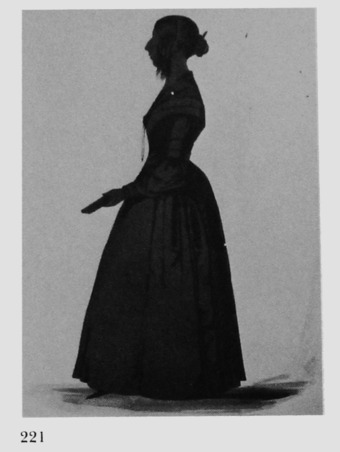
Unknown woman
Silhouette by Charles Hervé II, probably c. 1843-44.
costume dating points
The hair, dressed in the second style described in the text under ‘ 1840-50’.
The long necklace, fashionable during this decade.
The fill-in of the chemisette type, made without sleeves.
The bodice, worn with a Bertha to cover the shoulders.
The Victoria sleeve, tight above and full below the elbow.
The skirt, long enough to touch the toe and with (apparently) organ-pleating at the back.
The bustle, worn at the back to increase the bulk of the dress below the waist.
The fashionably tiny shoe.
Author’s collection
Chapter 9
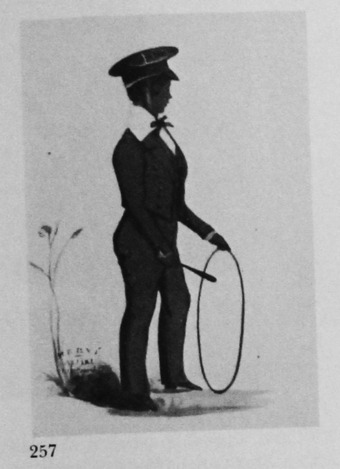
Unknown boy (aged about twelve)
Silhouette by Charles Hervé II, c. 1843.
costume dating points
The rather long hair, just visible under the cap.
The peaked cap, still in fashion at this date for boys of this age.
The rather wide, flat turn-down collar (tied by a black bow), which was to become smaller late in the decade.
The Eton suit (standard wear for schoolboys from the 1820s), worn, apparently, with pantaloons (not strapped).
The sitter appears to be wearing boots or half-boots, for there is no sign of any strings for tying shoes.
J. A. Pollak collection
SECTION ONE
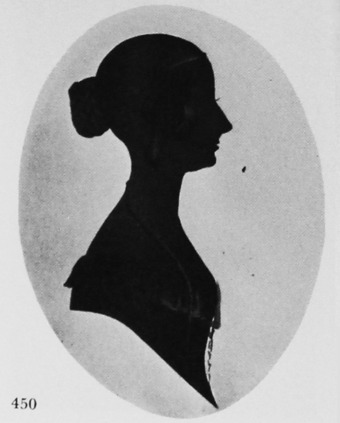
Marianne Noble
Cut silhouette, painted in black and Chinese white
? c. 1842
3 3/8 x 2½in./86 x 64mm.
Stencil (Oxford Street and Regent Street)
Frame: papier mâché
One of several silhouettes taken by Hervé of members of the Noble family. Painted on dark-grey paper.
Author’s collection
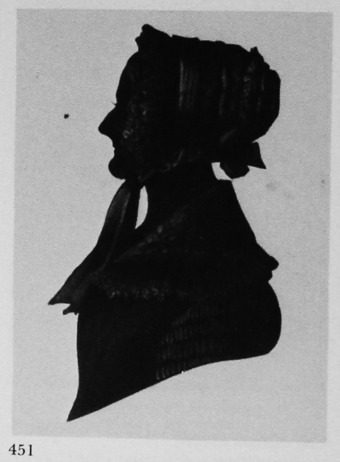
Unknown woman
Cut silhouette, with fine pencilled gilding
c. 1844
4½ x 3½in./115 x 90mm.
Frame: maple
Painted on very dark-grey paper.
Taken at 172 Oxford Street, London.
R. Kilner collection
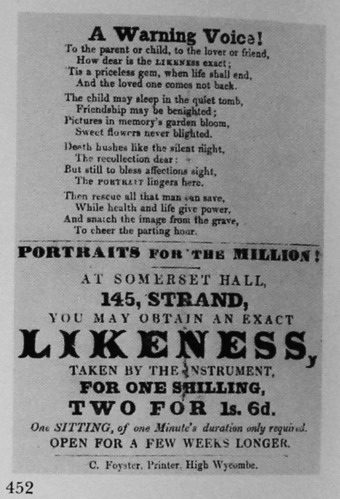
Handbill, possibly designed by Charles Hervé II and showing Alfred Hervé’s address at 145 Strand, London.
Bodleian Library, John Johnson collection
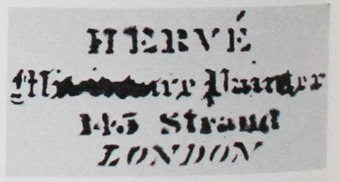
Stencil of Charles Hervé II, used for a short time at 145 Strand, London. From the reverse of a painted copy of a silhouette (834) taken in John Miers’s studio.
J. A. Pollak collection
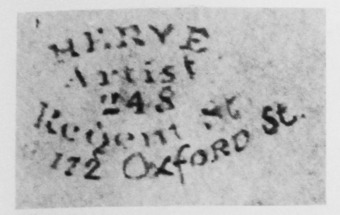
Stencil of Charles Hervé II, showing the two addresses 248 Regent Street and 172 Oxford Street, London. From the reverse of the silhouette illustrated in 450.
Author’s collection
